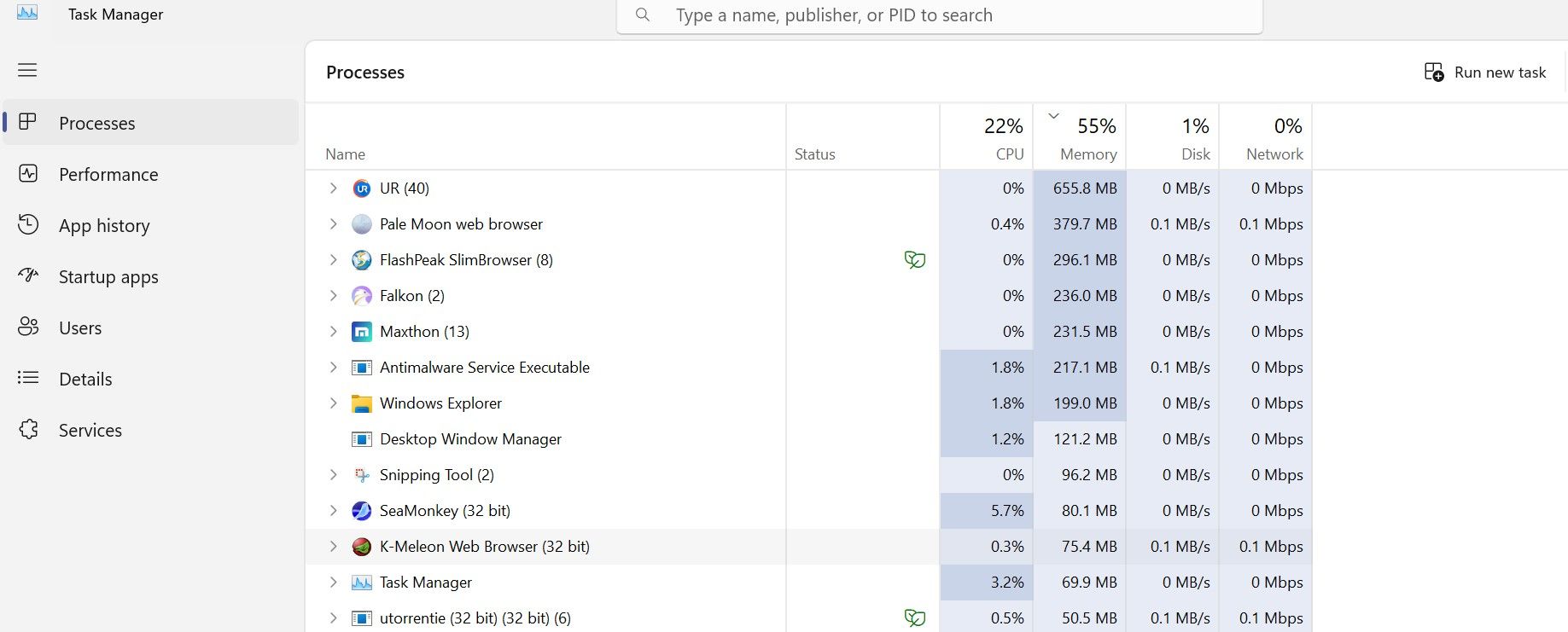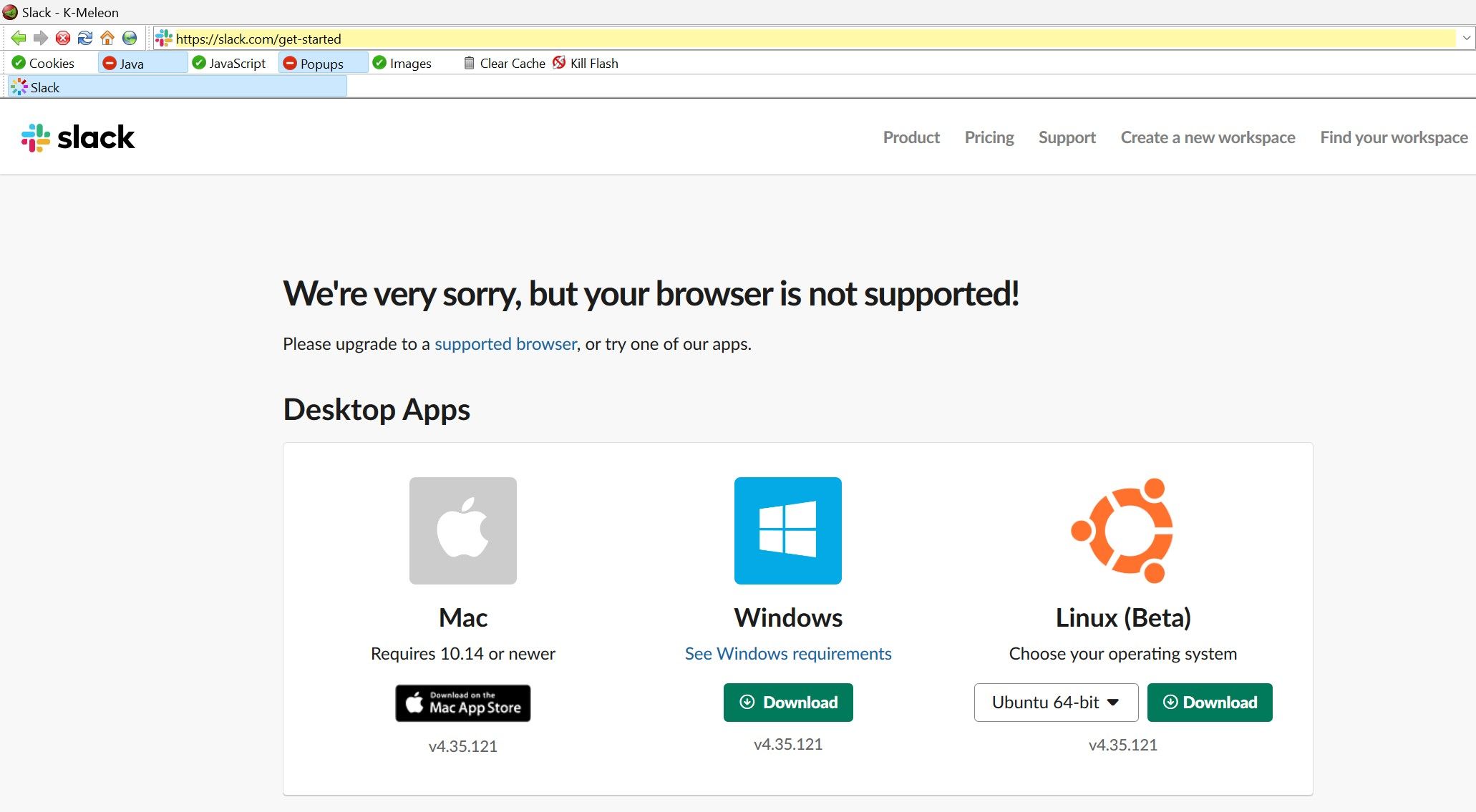
Low-Memory, High Performance: Comparing Best Windows Browsers

Low-Memory, High Performance: Comparing Best Windows Browsers
Using a resource-intensive browser on a low-end computer can adversely affect its performance. So, the optimum solution is opting for a lightweight browser alternative that doesn’t drain memory. We tested the RAM consumption of various resource-efficient browsers so that you can select the lightest one for your needs.
How Were the Tests Carried Out?
The resource consumption of browsers depends on how you use them. While a browser may be less resource-demanding when running web apps, it may not be as resource-efficient when playing videos.
For this reason, we chose seven lightweight browsers: K-Meleon, Falkon, SlimBrowser, Pale Moon, Maxthon, SeaMonkey, and UR Browser. Then, we tested them considering three typical everyday scenarios: entertainment, office, and work.

To simplify the comparison of resource consumption by different browsers, we kept the processes consistent, i.e., we ran the same processes for each scenario across all browsers.
Here are the processes we ran on the browsers when testing memory consumption for each everyday scenario:
1. Entertainment: Using a browser for entertainment typically involves surfing YouTube, streaming movies, listening to music online, etc. We ran four different processes in separate tabs to thoroughly assess memory usage for entertainment. Among them were two YouTube videos (one was paused, and the other was actively playing), a movie, and a song.
2. Work: In the office, we primarily use browsers to run web apps, go through our emails in an email client, occasionally watch YouTube tutorials, or work in a CMS (content management system). Thus, to test RAM consumption, we ran processes in four tabs: one with Google Sheets, the second with a content management system, another with an email client, and the fourth with a YouTube tutorial.
3. General Use: This includes reading news, scrolling Twitter or Facebook, and shopping online. Therefore, like in the previous use cases, we opened four tabs: one for Twitter, one for Facebook, another for an online shopping website, and the last for a news article.
We used the Windows Task Manager to measure RAM consumption, not the built-in task managers offered by some browsers. So, checking resource consumption via a built-in task manager on any of the tested browsers may differ from the values mentioned below.
An Overview of RAM Consumption by Various Browsers
Here is a table showing how much RAM each browser consumed for the three use cases mentioned above:
| Browser Name | Use Case | Memory Consumption (MBs) |
|---|---|---|
| K-Meleon | Idle | 78 |
| Entertainment | 450 | |
| Work | 526 | |
| General Use | 320 | |
| Falkon | Idle | 235 |
| Entertainment | 1749 | |
| Work | 1170 | |
| General Use | 935 | |
| Slim Browser | Idle | 320 |
| Entertainment | 968 | |
| Work | 1000 | |
| General Use | 902 | |
| Pale Moon | Idle | 175 |
| Entertainment | 830 | |
| Work | 805 | |
| General Use | 820 | |
| Maxthon | Idle | 323 |
| Entertainment | 875 | |
| Work | 1172 | |
| General Use | 790 | |
| SeaMonkey | Idle | 82 |
| Entertainment | 550 | |
| Work | 570 | |
| General Use | 562 | |
| UR Browser | Idle | 239 |
| Entertainment | 831 | |
| Work | 921 | |
| General Use | 647 |
There are a few conclusions you can draw from the results gathered during testing:
- K-Meleon consumes the least resources, while Falkon is the most resource-hungry.
- K-Meleon and SeaMonkey consume very little memory when idle, while SlimBrowser consumes the most.
- After K-Meleon and SeaMonkey, Pale Moon is your best choice for watching YouTube videos, streaming movies, and listening to music and office work.
- UR Browser appears to be the best option for general web browsing after K-Meleon and SeaMonkey.
The testing was conducted on a Microsoft Surface 3 laptop with 16GB of RAM. Considering that the actual resource consumption of any app or browser depends on various factors, including the RAM’s efficiency, the device’s manufacturer, its age, the actual RAM usage of the browsers tested above may slightly differ on your device.
Why K-Meleon and SeaMonkey Might Not Be the Best Choice?

K-Meleon and SeaMonkey are the least resource-intensive browsers, but they may not be the best choice for the above use cases.
Compared to the other browsers on this list, K-Meleon is extremely slow, and its interface isn’t intuitive, so it may take a while to get used to it. Most importantly, the browser doesn’t support mainstream web apps like Slack. Using social media web apps on K-Meleon is also challenging, as they frequently return errors.
SeaMonkey, on the other hand, has an equally complex interface. Many basic features, such as opening a new tab, are buried in the browser menus. Likewise, you need to right-click and open the context menu to close a tab. Therefore, using it as your primary browser will undoubtedly impede your productivity.
Considering all the disadvantages that each browser has, it is fair to say that K-Meleon and SeaMonkey aren’t the best choices for regular use. Despite being the least resource-intensive, these reasons make both browsers unfit for our use cases. To learn more about the tested browsers’ features and limitations, check out our guide on the best old and low-end browsers .
If your RAM consumption spikes to 100 percent in Task Manager even when your browser is idle and you have no tabs open, your RAM could be near exhaustion .
Which Browser Should You Use?
After eliminating K-Meleon and SeaMonkey, Pale Moon and UR Browser became the two top contenders to be the most lightweight and feature-rich browsers.
1. Pale Moon
Pale Moon is based on a derivative of the Gecko rendering engine (Goanna) and builds on a hard fork of the Mozilla code called UXP. The browser is fast, has a simple user interface, and offers high-end security. Furthermore, it is the least resource-intensive browser for work-related use after K-Meleon and SeaMonkey.
Therefore, Pale Moon should be your first choice if you are looking for a feature-rich, less demanding browser for use in the office.

Download: Pale Moon for Windows
2. UR Browser
The UR Browser is built with Chromium but has been stripped of some Google trackers for enhanced privacy protection. The browser has an easy-to-use interface, supports extensions on the Chrome web store, and offers advanced privacy features. Also, the browser is equipped with a built-in ad-blocker and VPN.
Combining these features makes UR Browser a good choice for entertainment and general use, especially if you are switching from Chrome.

Download: UR Browser for Windows
Browsers are not the only processes that secretly consume your device’s memory. You need to turn off every resource-consuming process to reduce RAM usage .
Use a Lightweight Browser to Lower Your RAM Usage
Excessive memory consumption by a browser can significantly impact device performance. Thus, you should use a browser that strains your RAM the least. Hopefully, our testing has given you an idea of which browser is less resource-intensive for work, entertainment, and general use.
However, it would not be wise to choose a browser solely based on how few resources it consumes. Instead, you should also consider additional features and integrations it offers, including support for extensions, the ease of managing downloads, privacy protection, and more.
- Title: Low-Memory, High Performance: Comparing Best Windows Browsers
- Author: David
- Created at : 2024-08-15 23:53:43
- Updated at : 2024-08-16 23:53:43
- Link: https://win11.techidaily.com/low-memory-high-performance-comparing-best-windows-browsers/
- License: This work is licensed under CC BY-NC-SA 4.0.



 Video Converter Factory Pro
Video Converter Factory Pro